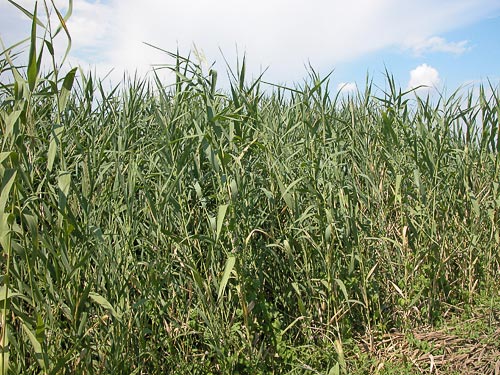Weeds
Phragmites australis (Cav.) Trin. ex. Stend - Common Reed.
Systematic position.
Family Poaceae (Graminea), genus Phragmites.Synonyms.
Arundo australis Cav., Phragmites communis Trin.Biological group.
Rhizome perennial weed.Morphology and biology.
Stem with numerous nodes, up to 5 m in height. Rhizome rather branchy. Leaf lanceolate-linear or linear, 5-25 mm in width, flat. Panicle large, up to 30 cm in length. Spikelets 6-17 mm in length, 3-7-floral, dark violet; spicate scales lanceolate; lower ones 2.5-5 mm in length; upper ones 3-9 mm in length. The lower floral scale is coriaceous-membraneous, with subulate apex exceeding length of scales. Blossoming occurs in July-August; fructifying occurs in August-September, but not annually. One inflorescence forms up to 50,000-100,000 seeds. Minimum temperature for germination is 8-10°C; optimum temperature is 20°C. Germination occurs in the light, from surface of ground or from depths of no more than 0.5-1.0 cm. Seeds remain viable for one year.Distribution.
The European part of Russia, the Caucasus and Ciscaucasia, Western Siberia, Eastern Siberia (except Arctic regions), all areas of the Far East (except Arctic regions), and Central Asia. Absent in deserts.Ecology
Hygrophilous plant. It is widely distributed in lands with close-standing, subsoil waters (2.0-2.5 m). Grows in coastal zone, along coasts of rivers and lakes, frequently in water, grassy marshes, boggy meadows, forest edges, bogs, crude meadows, and solonetz soils. Frequently forms continuous thickets.Economic significance.
Malicious segetal weed. It is widely distributed on irrigated grounds, where it infests all agricultural crops, especially rice, cotton, and lucerne. Small parts of rhizomes take root easily; therefore, inter-row treatments promote vegetative reproduction of the Common Reed. Main control measures include drainage, dehydration of soil surface after watering, deep and repeated treatments of ground, and crop rotation with alternation of rice and periodically watered cultivars.Related references.
Gubanov I.A., Kiseleva K.V., Novikov V.S., Tikhomirov V.N. 2002. The illustrated keys to plants of Middle Russia. V.1, Moscow: KMK, 526 p. (In Russian)Minyaev N.A., ed. 1970. Synopsis of flora of Pskov Region. Leningrad: Leningrad University. 176 p. (In Russian)
Nikitin V.V. 1983. Weeds in the flora of the USSR. Leningrad: Nauka. 454 p. (In Russian)
Tsvelev N.N. 1976. Cereals of the USSR. Leningrad: Nauka, 788 p. (In Russian)
Ulyanova T.N. 1998. Weeds in the flora of Russia and other CIS states. St.Petersburg: VIR. 344 p. (In Russian)
Vasileva L.I. & Matsenko A.E. 1964. Keys to weed plants of the Virgin Lands. Moscow & Leningrad: Nauka, 132 p. (In Russian)


